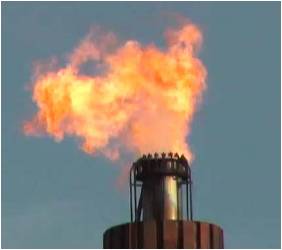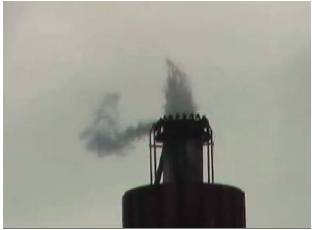Marathon Petroleum Company - LP and Catlettsburg Refining - LLC Settlement (Flaring)
(Washington, DC - April 05, 2012) The Department of Justice and the U.S. Environmental Protection Agency (EPA) today announced an innovative environmental agreement with Ohio-based Marathon Petroleum Company that already has significantly reduced air pollution from all six of the company’s petroleum refineries. In a first for the refining industry, Marathon has agreed to state‑of‑the‑art controls on combustion devices known as flares and to a cap on the volume of waste gas it will send to its flares. When fully implemented, the agreement is expected to reduce harmful air pollution by approximately 5,400 tons per year and result in future cost savings for the company.
The settlement is part of the EPA’s national effort to reduce air pollution from refinery, petrochemical, and chemical flares. A flare is a mechanical device, ordinarily elevated high off the ground, used to combust waste gases. The more waste gas a company sends to a flare, the more pollution that occurs. The less efficient a flare is in burning waste gas, the more pollution that occurs. EPA wants companies to flare less, and when they do flare, to fully combust the harmful chemicals found in the waste gas.
On this page:
- Overview of Company and Location of Facility
- Violations
- Injunctive Relief
- Environmental Mitigation Project
- Pollutant Reductions
- Health and Environmental Effects
- Civil Penalty
- MPC's Unique Level of Cooperation
- Comment Period
- Contact
Overview of Company and Location of Facility
Marathon Petroleum Company, LP and Catlettsburg Refining, LLC ‘s(collectively “MPC”) six refineries in the United States process approximately 1.15 million barrels per day (bpd) of crude oil. While MPC’s refining capacity ranks it as the fifth largest in the United States (15% of U.S. refining capacity), MPC does not own or control oil and gas reserves and does not engage in crude oil exploration or production. MPC processes a broad range of crude oils from domestic and international sources and produces products including asphalt, gasoline, diesel fuels, and propane. MPC is the top asphalt producer in the U.S. and operates an extensive retail operation located primarily in the Midwest.
Violations
The complaint alleges violations of Clean Air Act (CAA) requirements at MPC’s 22 steam‑assisted flares that resulted in excess emissions of volatile organic compounds (VOCs) and various hazardous air pollutants (HAPs) including benzene. The complaint allegations include violations of:
- New Source Review/Prevention of Significant Deterioration (NSR/PSD) and Minor New Source Review, 40 C.F.R. Parts 51 and 52
- New Source Performance Standards (NSPS), 40 C.F.R. Part 60, Subparts A, J, VV, VVa, GGG, and GGGa
- National Emission Standards for Hazardous Air Pollutants (NESHAP), 40 C.F.R. Part 63, Subparts A, CC, and UUU
- Title V and the Title V permits at MPC’s Refineries
- State Implementation Plan (SIP) requirements
- Comprehensive Environmental Response, Compensation and Liability Act (CERCLA), 42 U.S.C. § 9603(a), and the Emergency Planning and Community Right-to-Know Act (EPCRA), 42 U.S.C. § 11004(b)
Injunctive Relief
The consent decree requires the following actions to resolve the CAA claims:
Flare Minimization/Caps

Well Operating Flare – High Combustion Efficiency
- Submit and implement a waste gas minimization plan which is a very detailed plan for reducing waste gas to flares
- Update the enforceable plan on a yearly basis
- Undertake a root cause analysis and implement corrective action for “Reportable Flaring Incidents” (i.e., greater than 500 lb/day SO2 or 500,000 standard cubic feet per day (“scfd”) waste gas flow)
- Take limits on flaring, i.e., flaring caps
- 30-day rolling average limit for individual flares or groups of flares
- 365‑day rolling average limit for each refinery (varies depending on refinery size but equals approximately 500,000 scfd per 100,000 barrels per day capacity
Flare Efficiency

Poorly Operating Flare/Over Steamed – Low Combustion Efficiency
- Comply with current regulatory standards
- Install and operate the following monitoring systems and equipment on the 22 flares covered by the settlement: Vent Gas Flow Meter; Steam Flow Meter; Steam Control Equipment; Gas Chromatograph; Meteorological Station (at each refinery, not each flare)
- Automate the control of steam addition and supplemental gas (i.e. gas used to increase the net heating value of the gas being flared) in order to achieve high combustion efficiency
- Comply with the following limits:
- Net Heating Value in the Combustion Zone Gas (“NHVcz”) must be greater than or equal to the NHVcz-limit; both are calculated dynamically every 15 minutes
- Steam/Vent Gas ratio must be either 2.7 or less on a volumetric basis or 3.0 or less on a mass basis
- Add supplemental gas when wind effect makes the flare flame unstable
- 98% Combustion Efficiency
MPC estimates its past and future costs on flare efficiency control will total $51.5 million on flare efficiency control and that it will spend an additional, undetermined sum on flare minimization, flare caps and compliance with NSPS Subparts J and Ja.
Environmental Mitigation Project
As an environmental mitigation project, MPC is required to control the sludge handling system at its Detroit Refinery. These controls are projected to reduce at least 15 tons per year of VOCs and at least one ton per year of benzene. The cost of this project is estimated at approximately $2.2 million.
Sludge is a pollutant containing semi-solid material that is generated during the processing of wastewater. It can off‑gas VOCs and other volatiles to the atmosphere. MPC can legally emit VOC and benzene emissions from its Detroit sludge handling system because the emissions are within the allowable amount pursuant to MPC’s Benzene Waste Operations NESHAP (40 C.F.R. Part 61, Subpart FF) compliance option. This project will involve replacing open-air units with units closed to the environment, and installing controls on several tanks.
Pollutant Reductions
Because MPC started implementing controls during settlement talks, EPA estimates the following pollution reductions occurred by the end of 2011:
- VOCs 4,720 tpy
- HAPs 110 tpy
MPC projects additional reductions between 2012 and CD implementation as follows:
- VOCs 530 tpy
- HAPs 30 tpy
Therefore total emission reductions are estimated at:
- VOCs 5,250 tpy
- HAPs 140 tpy
These levels represent a 94% reduction in VOCs (from approximately 5610 to 360 tpy) and a 91% reduction in HAPs (from approximately 151 to 13).
Health and Environmental Effects
- Volatile Organic Compounds - VOCs, along with NOx, play a major role in the atmospheric reactions that produce ozone, which is the primary constituent of smog. People with lung disease, children, older adults, and people who are active can be affected when ozone levels are unhealthy. Ground-level ozone exposure is linked to a variety of short-term health problems, including lung irritation and difficulty breathing, as well as long-term problems, such as permanent lung damage from repeated exposure, aggravated asthma, reduced lung capacity, and increased susceptibility to respiratory illnesses such as pneumonia and bronchitis.
- Benzene - Acute (short-term) inhalation exposure of humans to benzene may cause drowsiness, dizziness, headaches, as well as eye, skin, and respiratory tract irritation, and, at high levels, unconsciousness. Chronic (long-term) inhalation exposure has caused various disorders in the blood, including reduced numbers of red blood cells and anemia in occupational settings. Reproductive effects have been reported for women exposed by inhalation to high levels, and adverse effects on the developing fetus have been observed in animal tests. Increased incidences of leukemia have been observed in humans occupationally exposed to benzene. EPA has classified benzene as a Group A human carcinogen.
Civil Penalty
MPC will pay a $450,000 civil penalty to the United States to resolve the CAA violations and $10,000 to resolve EPCRA/CERCLA violations.
MPC’s Unique Level of Cooperation
MPC has provided a unique level of resources, expertise, and assistance to EPA to develop and advance the scientific knowledge and technology for measuring emissions of VOCs and HAPs from industrial flares, including but not limited to:
- Developing the protocol for and conducting the first‑ever test of emissions from an operating, industrial flare using a then‑new measurement technology called Passive Fourier Transfer Infrared (“PFTIR”) Spectroscopy
- Implementing the PFTIR test at its Texas City refinery over a range of vent gas compositions and steam‑to‑vent‑gas ratios to better define how to achieve 98% combustion efficiency (“CE”) from operating, industrial flares
- Replicating the PFTIR test at another operating flare at the Detroit Refinery to improve the test method and accelerate technology development
- Assuring rigorous and scientifically valid data collection
- Preparing comprehensive and thorough PFTIR test reports for general distribution and use
- Assisting in generating a consensus regarding the validity of PFTIR as a method for measuring emissions from flares
Comment Period
The proposed settlement is lodged in the U.S. District Court for the Eastern District of Michigan. The consent decree will be subject to a 30-day public comment period and final court approval. Information on submitting comments is available at the Department of Justice website.
For more information, contact:
Robert Parrish
Attorney
U.S. Environmental Protection Agency (2242A)
1200 Pennsylvania Ave., N.W.
Washington, DC 20460-0001
(202) 564-6946
parrish.robert@epa.gov
